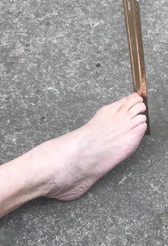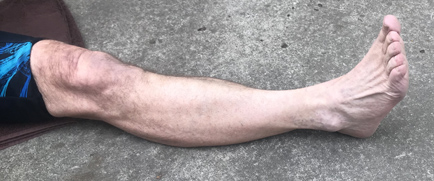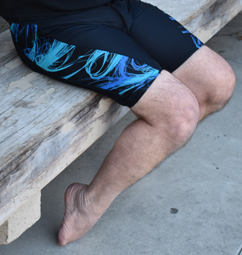This page has a project for my swim students they can work on at home.
Wikipedia tells us that “Michael Fred Phelps II is an American former competitive swimmer and the most successful and most decorated Olympian of all time, with a total of 28 medals. Phelps also holds the all-time records for Olympic gold medals, Olympic gold medals in individual events, and Olympic medals in individual events.”
Michael Phelps is sooooooo fast, he can swim the length and back of the De Anza College large pool (50 meters each way, 100 meters total) in less time than it takes some of my students to swim across the width of the pool (25 yards.) (His record for 100 meters in Beijing in August 2008 was 47.51 seconds.)
He got to be this fast mostly because he swam miles and miles
and had great coaching since he was 11 years old.
But he had a few other advantages. He is tall and thin with long legs.
His feet are size 14, so his feet are bigger flippers than most people have.
Most of my students have the same width of their arms as they are tall.
(Someone can measure your arm span from finger tips to finger tips with your arms outstretched if you want to compare to your height and sometimes we do this the first day of class.)
Michael Phelps’ arm span of 6 feet 7 inches is three inches more than his height,
so he has longer arms than many people.
Phelps can point his toes as far as (or some say more than) the “pointe” of a ballet dancer,
allowing more flex for his feet to be even better fins.
It is as if he were designed to be fast at butterfly swimming.
Most of my swim students enter the class with very little toe point. People who tell me they are runners, soccer and rugby players or who did a lot of marching band, usually have tight ankles compared to what Phelps has.
People who have worked on stretching to get a better toe point have told me they made surprisingly great progress by the end of the quarter. AND they become faster swimmers in the process by turning their feet into better fins!
USMS (United States Masters Swim)
explains the problem and why it is important for a swimmer :
“Limited ankle flexibility —Your feet are dorsiflexed (like when you’re standing) when swimming as opposed to plantar flexed (toes pointed), such as when you’re running. The position of your feet causes your knees to bend and your flutter kick looks more like you’re on the elliptical machine.”
“Ankle flexibility is crucial —When it comes to generating propulsion with your kick, keeping your ankles loose enables you to make contact against the water with the top of your foot. Just as in running you contact the ground with the soles of your feet, in swimming your downward strike comes from the top of your foot.”
You can have someone measure your toe point. Sit or lie on the ground/ floor, with your legs straight, thighs and calves staying flat on the floor, heels on the floor, no bend in your knees. Have someone hold a ruler at the end of your foot and you can try to point your toes as far down the ruler, towards the floor as you can.
Down to 2 inches is great,
many of my students can’t point below 6 inches and benefit from any amount of greater flexibility they can attain.
Before you try any stretching, please read and follow the safety rules at:
the Mayo Clinic page: advice on stretching
where it says: “Stretching essentials
Before you plunge into stretching, make sure you do it safely and effectively. While you can stretch anytime, anywhere, proper technique is key. Stretching incorrectly can actually do more harm than good.
Use these tips to keep stretching safe:
Don’t consider stretching a warmup. You may hurt yourself if you stretch cold muscles. Before stretching, warm up with light walking, jogging or biking at low intensity for 5 to 10 minutes. Even better, stretch after your workout when your muscles are warm.
Consider skipping stretching before an intense activity, such as sprinting or track and field activities. Some research suggests that pre-event stretching may actually decrease performance. Research has also shown that stretching immediately before an event weakens hamstring strength.
Strive for symmetry. Everyone’s genetics for flexibility are a bit different. Rather than striving for the flexibility of a dancer or gymnast, focus on having equal flexibility side to side (especially if you have a history of a previous injury). Flexibility that is not equal on both sides may be a risk factor for injury.
Focus on major muscle groups. Concentrate your stretches on major muscle groups such as your calves, thighs, hips, lower back, neck and shoulders. Make sure that you stretch both sides.
Also stretch muscles and joints that you routinely use or that you use in your activity.
Don’t bounce. Stretch in a smooth movement, without bouncing. Bouncing as you stretch can injure your muscle and actually contribute to muscle tightness.
Hold your stretch. Breathe normally and hold each stretch for about 30 seconds; in problem areas, you may need to hold for around 60 seconds.
Don’t aim for pain. Expect to feel tension while you’re stretching, not pain. If it hurts, you’ve pushed too far. Back off to the point where you don’t feel any pain, then hold the stretch.
Make stretches sport specific. Some evidence suggests that it’s helpful to do stretches involving the muscles used most in your sport or activity. If you play soccer, for instance, stretch your hamstrings as you’re more vulnerable to hamstring strains.
Keep up with your stretching. Stretching can be time-consuming. But you can achieve the most benefits by stretching regularly, at least two to three times a week. Even 5 to 10 minutes of stretching at a time can be helpful.
Skipping regular stretching means that you risk losing the potential benefits. For instance, if stretching helped you increase your range of motion, your range of motion may decrease again if you stop stretching.
Bring movement into your stretching. Gentle movements, such as those in tai chi, Pilates or yoga, can help you be more flexible in specific movements. These types of exercises can also help reduce falls in older adults.
Also, try performing a “dynamic warmup.” A dynamic warmup involves performing movements similar to those in your specific sport or physical activity at a low level. Then you speed up gradually and add intensity as you warm up.
Some people may also choose to add foam rolling before working out along with a dynamic warmup.
Know when to exercise caution
If you have a chronic condition or an injury, you might need to adjust your stretching techniques. For example, if you already have a strained muscle, stretching it may cause further harm. Talk to your doctor or physical therapist about the most appropriate way to stretch if you have any health concerns.
Also remember that stretching doesn’t mean you can’t get injured. Stretching, for instance, won’t prevent an overuse injury.”
– – – – – – – – – – – – – – – – – – – – – – – – – – – – – – – – – – – – – – – – – –
Stretching should feel good, not hurt.
You are not going to get a better toe point in a matter of a few days or weeks!
If a doctor, physical trainer or physical therapist told you to stretch a different way than described below, do what they say.
If you have had an injury to your toes, feet, ankles or legs ask the doctor about this before you try it.
To stretch your ankles you can sit on a bench at poolside / in a chair at home with your feet under the bench or chair, knees very bent, toes on the floor, toes pointed as far as is comfortable. Then push your shins down towards the floor just a little until you feel your ankles stretch (just a little) and hold it for 10 to 20 seconds.
You can do this multiple times a day. It can get to be a habit and not really take extra time out of your day. You won’t even be in the swimming pool, but you will become a faster swimmer!
(Later when you try figure skating or dancing
you might notice the difference.)
U.S. Masters Swimming has tips for stretching for swimmers.https://www.usms.org/fitness-and-training/articles-and-videos/articles/what-swimmers-should-know-to-develop-a-stretching-routine
![]()
Swimmers can truly benefit from stretching their lower leg calves after each swim class
(and after a long walk, hike, tour of a museum, etc.) to help prevent muscle cramps.
The Mayo Clinic has a stretch for calves (and links to many other stretches)





